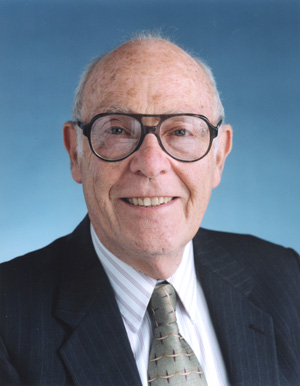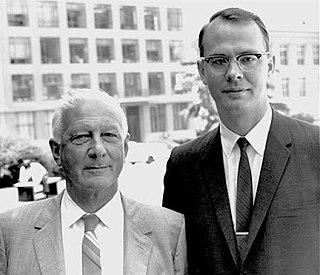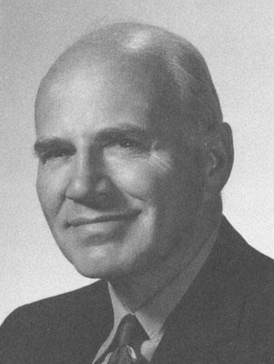Related Research Articles

Metallurgy is a domain of materials science and engineering that studies the physical and chemical behavior of metallic elements, their inter-metallic compounds, and their mixtures, which are known as alloys. Metallurgy encompasses both the science and the technology of metals; that is, the way in which science is applied to the production of metals, and the engineering of metal components used in products for both consumers and manufacturers. Metallurgy is distinct from the craft of metalworking. Metalworking relies on metallurgy in a similar manner to how medicine relies on medical science for technical advancement. A specialist practitioner of metallurgy is known as a metallurgist.

Cyril Stanley Smith was a British metallurgist and historian of science. He is most famous for his work on the Manhattan Project where he was responsible for the production of fissionable metals. A graduate of the University of Birmingham and Massachusetts Institute of Technology (MIT), Smith worked for many years as a research metallurgist at the American Brass Company. During World War II he worked in the Chemical-Metallurgical Division of the Los Alamos Laboratory, where he purified, cast and shaped uranium-235 and plutonium, a metal hitherto available only in microgram amounts, and whose properties were largely unknown. After the war he served on the Atomic Energy Commission's influential General Advisory Committee, and the President's Science Advisory Committee.

Vannoccio Biringuccio, sometimes spelled Vannocio Biringuccio, was an Italian metallurgist. He is best known for his manual on metalworking, De la pirotechnia, published posthumously in 1540.

The Wright Flyer made the first sustained flight by a manned heavier-than-air powered and controlled aircraft—an airplane—on December 17, 1903. Invented and flown by Orville and Wilbur Wright, it marked the beginning of the pioneer era of aviation.
Morris Cohen, born in Chelsea, Massachusetts, United States, was a Jewish American metallurgist, who spent his entire career affiliated with MIT. He graduated from his undergraduate degree in 1933, receiving his doctorate three years later, and was appointed assistant professor of metallurgy in 1937. He was appointed Professor of Physical Metallurgy in 1946, and an Institute Professor in 1975. He took emeritus status in 1982.

John Werner Cahn was an American scientist and recipient of the 1998 National Medal of Science. Born in Cologne, Weimar Germany, he was a professor in the department of metallurgy at the Massachusetts Institute of Technology (MIT) from 1964 to 1978. From 1977, he held a position at the National Institute of Standards and Technology. Cahn had a profound influence on the course of materials research during his career. One of the foremost authorities on thermodynamics, Cahn applied the basic laws of thermodynamics to describe and predict a wide range of physical phenomena.
Archaeometallurgy is the study of the past use and production of metals by humans. It is a sub-discipline of archaeology and archaeological science.
Albert Sauveur was a Belgian-born American metallurgist. He founded the first metallographic laboratory in a university.

Antoine Marc Gaudin was a metallurgist who laid the foundation for understanding the scientific principles of the froth flotation process in the minerals industry. He was also a professor at the Massachusetts Institute of Technology, and during World War II developed there the ore-processing techniques needed to extract uranium from its low grade ores for the Manhattan Project. He was a founding member of the National Academy of Engineering.
Augustus Braun Kinzel was a noted American metallurgist and first president of the National Academy of Engineering.
Mats Hillert was a Swedish metallurgist who was an emeritus professor in metallography at the Royal Institute of Technology (KTH).
Heather Lechtman is an American materials scientist and archaeologist, and Director at the Center for Materials Research in Archaeology and Ethnology (CMRAE) at the Massachusetts Institute of Technology. She specializes in prehistoric technology of the Andean area of South America, and in particular metallurgy.
George Cameron Stone was a well-known American arms collector and author as well as an American mining engineer and metallurgist. He authored a glossary of the antique weapons of the world that remains one of the most comprehensive works ever written on the subject.

Patcha Ramachandra Rao was a metallurgist and administrator. He has the unique distinction of being the only Vice-Chancellor (2002–05) of the Banaras Hindu University (BHU) who was also a student (1963–68) and faculty (1964–92) at that institution. From 1992 to 2002, Rao was the Director of the National Metallurgical Laboratory, Jamshedpur. After his tenure as Vice-Chancellor of B.H.U., in 2005, he took the reins of the Defence Institute of Advanced Technology (DIAT) as its first Vice-Chancellor. He was to serve DIAT until his superannuation in 2007. From 2007 till the end, Rao was a Raja Ramanna Fellow at the International Advanced Research Centre for Powder Metallurgy and New Materials, in Hyderabad, Andhra Pradesh.
Brahm Prakash, was a metallurgist known for his work with nuclear materials in India.

John Frank Elliott (1920–1991) was an American professor of metallurgy who made significant contributions to the science of pyrometallurgy during his long career at Massachusetts Institute of Technology (MIT).
Prafulla Kumar Jena was an Indian metallurgist who served as director of the National Institute for Interdisciplinary Science and Technology of the Council for Scientific and Industrial Research, Bhubaneshwar. He previously held the TATA Chair for the Distinguished Professor of Metallurgical Engineering at the Indian Institute of Technology, Kharagpur. He was awarded the Padma Shri, India's fourth highest civilian award, in 1977.
David Vincent Ragone is an American metallurgist, famous for the Ragone chart. Ragone was the third President of Case Western Reserve University.
Chokkanathapuram Venkataraman Sundaram (1929–2008) was an Indian chemical metallurgist, best known for the commissioning of the Fast Breeder Test Reactor at Kalpakkam. He was the director of the Indira Gandhi Centre for Atomic Research (IGCAR). He was a recipient of the Sanjay Gandhi Award for Science and Technology as well as the National Metallurgists Day Award and an elected fellow of the Indian National Science Academy, the Indian Academy of Sciences and the Indian National Academy of Engineering. The Government of India awarded him the Padma Bhushan, the third highest civilian award, in 1986.
Ye Zhupei or Yap Chu-Phay was a Chinese physical chemist, chemical engineer, and metallurgist. Born into an overseas Chinese family in the Philippines and educated in the United States, he moved to China in the 1930s and served in both the Kuomintang and the Communist governments. Considered the founder of chemical metallurgy in China, he was elected a founding member of the Chinese Academy of Sciences (CAS) in 1955 and established the Institute of Chemical Metallurgy of the CAS in 1958. He was persecuted during the Cultural Revolution and died in prison after five years of incarceration.
References
- 1 2 3 "Martha Goodway '57". MIT Technology Review. Retrieved 2021-02-10.
- ↑ Roslindale High School Yearbook, 1952.
- ↑ CEE in Focus: Alumni News Archived 2015-12-24 at the Wayback Machine (Spring 2011), Civil and Environmental Engineering, Massachusetts Institute of Technology.
- ↑ Lynne Robinson, "Martha Goodway: How History is Made" Journal of Metallurgy 67(9)(2015): 1918–1920. doi : 10.1007/s11837-015-1572-8
- ↑ Ivan Amato, "Researchers Swap Material Evidence in Boston" Science 258(5090)(18 December 1992): 1886.
- ↑ Martha Goodway, "Etruscan Mirrors: A Reinterpretation" in Stuart J. Fleming and Helen R. Schenck, eds., History of Technology: The Role of Metals (UPenn Museum of Archaeology 1989): 25. ISBN 978-0-924171-95-6
- ↑ Paul Lee, Vignettes: Musings and Reminiscences of a Modern Renaissance Man (iUniverse 2012): 424-425. ISBN 978-1-4759-5655-9
- ↑ Frank W. Gayle and Martha Goodway, "Precipitation Hardening in the First Aerospace Aluminum Alloy: The Wright Flyer Crankcase" Science 266(5187)(11 November 1994): 1015–1017. DOI: 10.1126/science.266.5187.1015
- ↑ Jonathan Waldman, Rust: The Longest War (Simon & Schuster 2015): 27. ISBN 978-1-4516-9161-0
- ↑ Thomas Donahue, The Harpsichord Stringing Handbook (Rowman & Littlefield 2015): 1. ISBN 978-1-4422-4345-3
- ↑ Martha Goodway, "Iron" in Igor Kipnis, ed., The Harpsichord and Clavichord: An Encyclopedia (Routledge 2013): 267. ISBN 978-1-135-94978-5
- ↑ Martha Goodway and Jay Scott Odell, The Metallurgy of 17th- and 18th-Century Music Wire (Pendragon Press 1987). ISBN 978-0-918728-54-8
- ↑ Smithsonian Museum Conservation Institute, "Martha Goodway".